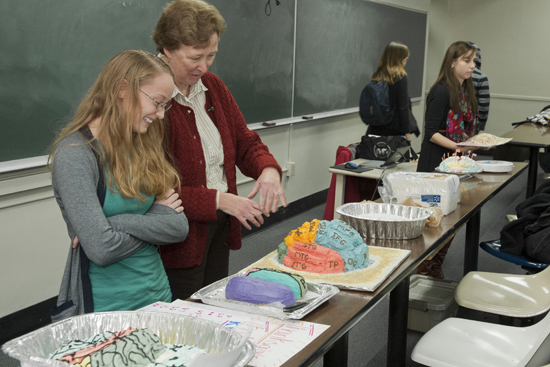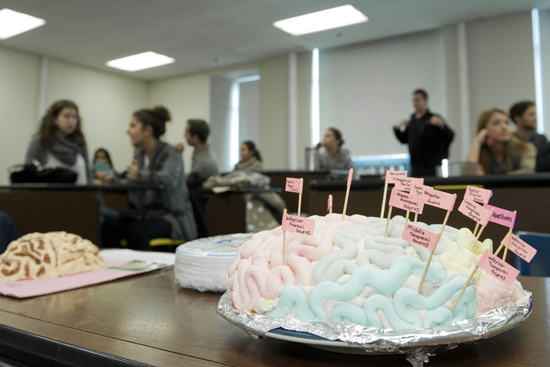Brain: It’s What’s for Dessert
Food competition a fun tool to teach neuropsychology

Mikayla Scaduto (CAS’13) (from left) and professor Alice Cronin-Golomb survey edible neuroanatomical specimens created by students in Cronin-Golomb’s third annual Edible Brain Competition. Photos by Kalman Zabarsky
Alice Cronin-Golomb knows a lot about the human brain. Her research into vision problems resulting from neurodegenerative diseases like Alzheimer’s and Parkinson’s has improved thousands of lives.
A dedicated professor, she has also found a highly creative and playful way to inspire her students to unlock the mysteries of the brain. And it all has to do with Jello, which she uses to create realistic-looking brains.
How did Cronin-Golomb, a College of Arts & Sciences professor of psychology and director of the Vision and Cognition Laboratory and the Center for Clinical Biopsychology, come about such arcane culinary knowledge?
Back in 1996, her former student, Tracy Dunne (GRS’92,’99), now a CAS lecturer in psychology, made a brain out of Jello for Cronin-Golomb’s tenure party. Cronin-Golomb liked the idea so much she started making her own from a recipe she found on the internet. The key, she says, is using a proper brain-shaped mold and a mixture of watermelon Jello and light evaporated skim milk, to give the organ a realistic gray color.
Two years ago, she decided to take her experiments with brain-themed cooking to a new level, by getting her students involved. It began when she asked her two daughters for ideas to improve her Neuropsychology 338 course, which explores the relationship between brain disorders resulting from head injuries, strokes, and degenerative diseases and abnormal behavior. Cronin-Golomb was looking for ways to build more interactivity into the class, to keep pace with a generation that is less tolerant of pure lecturing. Her then-15-year-old daughter, Lucy, asked, “Why don’t you let them bake brain cakes?”
At first, she dismissed the tongue-in-cheek idea. But as she thought more about it, she wondered, “why not?” The students would participate in a competition to make the best cake (or other edible creation) in the shape of a brain.
“The submissions would have to be anatomically accurate,” she recalls. “When I suggested it, the students jumped on the idea. They wanted to do it.”

Fast forward to a recent Thursday. More than 60 students assembled in CAS Room 222 for the third annual Edible Brain Competition. Eight teams faced off in pursuit of three honors: most anatomically accurate, most aesthetically pleasing, and most complex. The excitement mounted as team after team presented its edibles and explained its creative process.
“We did have a little trouble,” says Catherine Conlin (CAS’13), a neuroscience major who, along with Britahny Baskin (CAS’14), a neuroscience and psychology double major, made two cakes: a rat brain and a human brain. “We lost a hemisphere at one point.”
Neuroscience majors Rachel Franklin (CAS’14) and Rakhi Desai (CAS’14), like a number of their competitors, used Rice Krispies Treats to fortify their cake and make it more moldable. Their creation, dubbed the Thanksgiving Thalamus, depicted the part of the brain responsible for our ability to taste. “I love the thalamus because every sensory function goes through it except olfactory,” says Franklin.
Among the other cakes in the competition were ones featuring brains with Pick’s and Alzheimer’s diseases (both complete with pathological markers) and a horizontal slice showing the gustatory cortex (responsible for taste along with the thalamus) and thalamic nucleus.

The baking competition was just one highlight of the course, which included talks by practitioners in the field of neuropsychology as well as a trip to Harvard Medical School’s Warren Anatomical Museum. During that visit, Amanda Hanson (CAS’14) and her cake-making partner were inspired by the skull of Phineas Gage, a 19th-century railway construction worker who survived an accident in which a large iron rod was driven completely through his head.
“We wanted to make our cake a replica of his skull, but then we realized that it wasn’t from the right view to show the wound,” says Hanson.
When she heard the group’s reasoning for not pursuing the Gage skull replica, Cronin-Golomb was pleased. “I was very excited that the reason they stopped was not because it would have been hard to make,” she says, “but because recent research that the students read about has called into doubt the traditionally accepted trajectory of the rod through Gage’s brain, and that would have led their brain cake to be anatomically inaccurate.”
Cronin-Golomb’s class helps lay the foundation for many students’ careers in psychology and neuroscience. Students study neuroanatomy and learn how to make connections between psychological traits and the functioning of the brain. They also examine various neurological and psychological disorders and how they are diagnosed and treated.
“I try to take a fresh look at it every year, to find out ways to make my class more interesting and relevant,” says Cronin-Golomb.
The competition offered other perks. “It tasted really great,” says Lia Schneider (CAS’14). “I ate a lot of the cake during the process.”
Jeremy Schwab can be reached at jschwab@bu.edu.
Comments & Discussion
Boston University moderates comments to facilitate an informed, substantive, civil conversation. Abusive, profane, self-promotional, misleading, incoherent or off-topic comments will be rejected. Moderators are staffed during regular business hours (EST) and can only accept comments written in English. Statistics or facts must include a citation or a link to the citation.